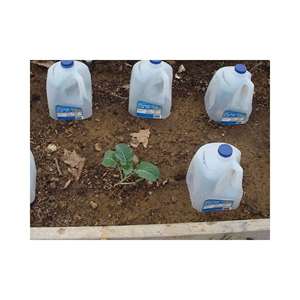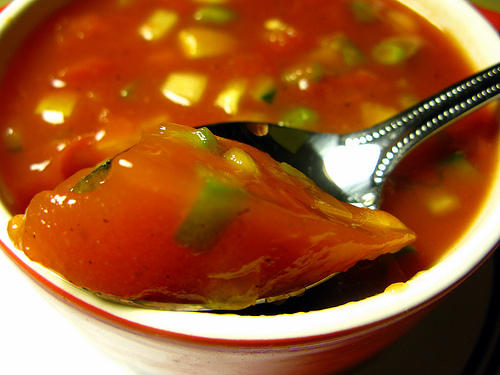Posts Tagged ‘Root Veggies’
Mid-West Drought to Cause Food Price Increases

As crops shrivel and die from lack of rainfall across the country food prices will undoubtedly go up in the months to come. First will be prices on short cycle commodities like eggs, poultry and milk; followed by spikes in meat and other products that utilize corn or corn by-products in their processing.
Now is the time to stock up on items that could be out of your reach in the future. It is also the time to get serious about growing your own food. In many parts of the country there is still time to plant short term crops like root veggies and salad greens. It is also a good time to plan your fall and winter garden, taking advantage of seeds that may be on sale now.
Take advantage of summer sales on meat and lay aside items that you don’t or can’t raise yourself. I’m keeping an eye on beef and pork sales, both commodities that will be hit hard by the current crop disasters. Even if I do decide to raise a pig this fall it will be months before I can enjoy the fruits of that labor. Filling in gaps now will keep me eating well until my own pig is in the freezer.
If possible, stock up on livestock feed you can use in the next few months, pushing out the sticker shock that’s bound to come. Non-molasses based feeds like lay mash, lay pellets, pig chow and the like will take a big jump in price as the corn and other grain crops wither in the fields. Be cautious with molasses feeds though as they can go rancid if not used in a timely manner.
Speaking of other grains, they too will likely follow suit, or food distributors will take full advantage of increasing prices on corn and jump on the price-hike bandwagon, pushing prices higher to make a bigger profit. Stocking up on wheat, flour, corn meal, rice, barley, millet, etc. could help keep your family eating well over the winter months.
Remember too, grains are long term crops, meaning they take months to go from just planted seeds to a harvestable crop. A decrease in price is not likely to be seen until mid- to late- 2013, if at all. I can still remember the huge jump local fruit prices took during a grocery store strike in the early 2000’s. Prices went from under a dollar a pound for most fruits to almost $2.00 a pound and prices have never come back down. Disaster situations, like the current drought, seem to be a way for food manufacturers to increase prices whether or not the products are directly affected by market conditions. What goes up does not always come down.
This is also a great time to reevaluate how you use the food you grow or buy. Americans throw away millions of dollars worth of food because they buy more than they can use, don’t store it properly or just don’t plan to use it before it goes bad. Buying less per trip could be a solution in managing your grocery budget. Getting creative about using up everything you buy is also another tactic to keep your food budget under control.
At our homestead we try to plan meals that use up bits of leftovers to serve filling and satisfying dishes. It’s amazing how small amounts of leftovers or fresh items can be transformed into an entire meal. Case in point…tonight we will be enjoying a skillet full of beef stroganoff made from a few mushrooms, half an onion, a small amount of chuck I bought in the clearance meat section, beef broth made and frozen last winter and a dab of sour cream. I always have noodles in the pantry and a small piece of French bread and a small salad of fresh greens will round out a perfect budget meal.
Stay tuned, folks. As times get tougher you’ll see a lot more tips on how we stretch our food dollars and make the most of what we buy.
Frosty Mornings and Milk Jug Cloches
 Two week out from our celebrated Spring Equinox, that day when we turn our backs on a long cold winter and look forward to the warming rays of spring, we have seen some of the coldest temps this season, along with our traditional spring norms in the 60s and 70s. Every morning when I get up I can see frost on neighboring rooftops, on lawns and on cars.
Two week out from our celebrated Spring Equinox, that day when we turn our backs on a long cold winter and look forward to the warming rays of spring, we have seen some of the coldest temps this season, along with our traditional spring norms in the 60s and 70s. Every morning when I get up I can see frost on neighboring rooftops, on lawns and on cars.
Traditionally our last frost date is March 15th and I normally try to direct sow root veggies the first weekend in March. It is also the time when I start a ton of other veggies for transplant later in the spring. With my garden just a few weeks under ground and the nightly lows in the 30s and 40s this usually stoic farm girl is quaking in her muck boots like an expectant mother. Was I too anxious to start gardening? Did I foolishly jump the gun? Perhaps. But, if I had not planted when I did I would not have had another opportunity until the first week in April; much too late to see a harvest of greens and early roots by Easter.
The seeds are in though and the only thing to do now is deal with what Mother Nature throws our way.
The remedy…crop covers; sometimes called cloches, which is French and sounds really cool.
Crop covers can be purchased or homemade. Purchased crop covers are sheets of semi-transparent clothe that can be placed over a garden bed, attached to the top of wire fencing or staked over flats of planted seedlings. It acts like a mini-greenhouse, trapping the warm sun of day and maintaining it throughout the night. A few degrees increase in temperature can mean the difference between garden survival and complete disaster.
In a pinch, even opaque containers can save your plants. However, if a hard freeze is on its way, cover plants as best you can and cross your fingers.
Scavenged or re-purposed materials like plastic sheeting or clear drop clothes can be used for larger outdoor beds. If you have a smaller garden area or a balcony or pot garden there are literally a zillion things you can use to protect your plants. Containers like clear soup tubs from take-out restaurants, deli containers, old refrigerator containers, and milk or juice jugs make great substitutes. Even glass jars that hold those massive amounts of food items from big box stores can be used, and are the most like a French cloche.
It doesn’t get any easier than washing out a container, removing the label to allow more light in and placing it upside down over your sprout. Give it a few twists into the soil to anchor it well then weigh it down with something heavy so it won’t blow over in the wind. If you’re area is prone to marauding critters, weigh it down with something heavier.
Milk cartons and juice jugs make great cloches for larger taller plants like tomatoes, cabbage and broccoli. Simply wash, remove the labels and cut off the bottom. Set it over your plant and push into the soil. The nice part about the jug system and the thing I like the most is that you can either drill a few holes in the lid or remove it all together (during the warm part of the day) so the inside doesn’t get too hot. Another benefit about the jugs is the 2-for-1 deal you get by cutting them in half across the middle, horizontally or down the middle, vertically. These work well for bushy shorter plants or lay it on its side over short rows of smaller plants.
Obviously glass containers can’t be cut in half and used in multiple ways, but they are the most like a traditional French cloche, which is a bell-shaped glass cover used to protect plants from frost, wind and rain. Plus, when stored in the off season they will last for a long time.
There are many different materials you can use, but the most important point is the container must be, at least, semi-transparent to let in the sun and its warmth. Also remember that protecting your plants is a day-by-day strategy. Covers should not be left on for days on end or the lack of sunlight (and over heating) will affect their growth.
Also remember that on warmer days, no covers are necessary. In fact, covering your plants during warm days can build up the heat inside, literally cooking your plants to death.
With a few recycled and homemade (or purchased) crop covers on hand you can protect your garden from harsh early spring weather.
Marching on little seedlings, March on!!


Recent comments
Aenean nonummy hendrerit mauris. Phasellus porta.